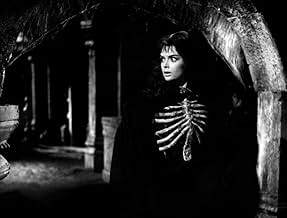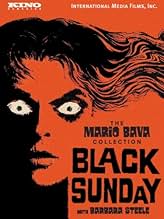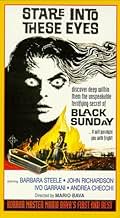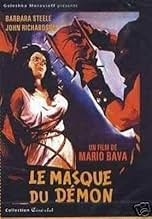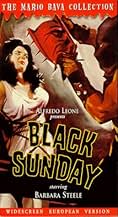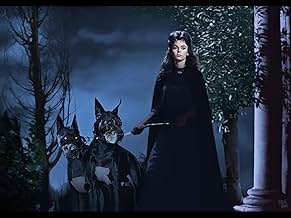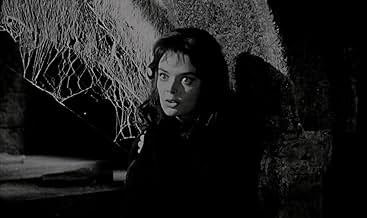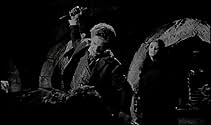AVALIAÇÃO DA IMDb
7,1/10
19 mil
SUA AVALIAÇÃO
Uma bruxa vingativa e o seu servo diabólico regressam da sepultura e iniciam uma campanha sangrenta para possuir o corpo da bela descendência da bruxa, com apenas o irmão da mulher e um belo... Ler tudoUma bruxa vingativa e o seu servo diabólico regressam da sepultura e iniciam uma campanha sangrenta para possuir o corpo da bela descendência da bruxa, com apenas o irmão da mulher e um belo médico de pé no seu caminho.Uma bruxa vingativa e o seu servo diabólico regressam da sepultura e iniciam uma campanha sangrenta para possuir o corpo da bela descendência da bruxa, com apenas o irmão da mulher e um belo médico de pé no seu caminho.
- Prêmios
- 1 vitória e 1 indicação no total
Barbara Steele
- Princess Asa Vajda
- (as Barbara Steel)
- …
Giuseppe Addobbati
- Priest
- (não creditado)
Fernando Cajati
- Crucifixion Torturer
- (não creditado)
Valentina Cortese
- Tavern Girl
- (não creditado)
Angelo Galassi
- Tavern Keeper
- (não creditado)
Nando Gazzolo
- Narrator
- (narração)
- (não creditado)
Renato Montalbano
- Spectator
- (não creditado)
Enredo
Você sabia?
- CuriosidadesMario Bava and Barbara Steele had a difficult working relationship. She sometimes refused to come to set because she did not like her wig or the fact that her cleavage would be shown. One time she refused because she believed Bava would force her to appear nude. She admits that she was difficult due to her inexperience and inability to understand Italian.
- Erros de gravaçãoIn the opening credits, Barbara Steele's name is misspelled as Barbara Steel.
- Citações
Princess Asa Vajda: You, too, can feel the joy and happiness of hating.
- Cenas durante ou pós-créditosFor "The Mask of Satan," the English language version prepared in Italy, Barbara Steele's name is listed as "Barbara Steel" on the trailer and on the credits of the film itself.
- Versões alternativasThe full list of differences between the 83-minute original cut and the 80-minute AIP cut:
- A different English-language dub, and a new score by Les Baxter.
- An added pre-text crawl warning the audience about the film's content: "The producers of the picture you are about to see feel a moral obligation to warn you that it will shock you as no other film ever has. Because it could be very harmful to young and impressionable minds, it is restricted to only those over fourteen years of age."
- Alternate opening credits.
- A brief exchange between Katja and Constantine where he tells her their father has died is cut.
- A scene where Katja and Andrej talk in the garden is cut.
- An exchange between Katja and Andrej outside her room is cut.
- Kruvajan's death scene is cut down significantly to remove shots of his eye spurting blood.
- The scene were Prince Vajda reanimates and menaces Katja is trimmed.
- Vajda's death scene, particularly the close-ups of his head melting, is trimmed.
- Asa taunting Andrej before being burned at the stake is cut.
- Added closing credits.
- ConexõesFeatured in As Motorizadas (1962)
Avaliação em destaque
BLACK Sunday (Mario Bava - Italy 1960).
Mario Bava's first feature as a director (although he did uncredited directorial work before), this classic and extremely influential piece of Gothic horror really showed his cinematographic talent in creating a haunting and stylishly shot film. "Black Sunday" also catapulted Barbara Steele to horror stardom and would make her into the undisputed horror queen of the sixties. Bava based "Mask of Satan", as the film was originally titled, on the short story "Vij" by the Russian author Gogol, which he adapted into a homage to the early Universal horror pictures he loved so much. Barbara Steele is the beautiful 17th century witch princess Asa, who is a vampire, and her lover Juvato (Arturo Dominici), are put to death by her vengeful brother. He has iron masks with spikes on the inside placed on both their faces and then sledgehammered home (the brutal opening scene). Two hundred years later, blood is accidentally spilled on Asa's face and she rises from the dead along with Juvato to wreak revenge on the descendants of those who executed her - including her look-alike Katia, also played by Barbara Steele.
Beautifully shot in black and white by Bava himself, "Black Sunday" is a perfect showcase of his masterful control of light and shade, of colour and movement (yes, one can play with "shades of colour" in black and white) and playful camera angles, it's a feast for the eye. At heart Bava would always remain the cinematographer he always was and in all his films he took an active role in the design of each image by setting up the lighting, the optical effects, the filters etc. The film abounds in old-fashioned horror atmosphere and in that department, it even manages to top the atmosphere of the Universal horror classics it was based on with gnarled tree branches, fogbound sets, a decaying castle, a dark foreboding crypt and much more.
Of course, Bava's is well known for letting stylistic innovations take precedent over storytelling and most other things involved, like acting. Much of the script was reworked during shooting and even in post-production. Barbara Steele reportedly never even saw a script and got some pages every day of shooting. Variations of the story has been told many times in one way or another and there are more than a few echoes of Murnau's Nosferatu here. Much of the story is too derivative to begin with, and has become too formularised in subsequent years to retain much of its original power, just as the film's capacity to scare or excite audiences has probably worn out a little over the years. It doesn't really matter, because the film was chopped to pieces for over four decades and the habit of Italian filmmakers of post-synchronizing all the voices (even for Italian versions) made anything in that department a pretty dire affair anyway.
What Bava added however was some substantially more explicit violence and gore, laced with sexual connotations. The opening scene in which the mask is sledgehammered to Barbara Steele's face still packs quite a wallop, not to mention the effect it must have had on audiences back then. Still, horror fans can't really afford to miss this quintessential Bava piece, but watch it for the splendid cinematography and Bava's unique ways of visual wizardry.
Camera Obscura --- 7/10
Mario Bava's first feature as a director (although he did uncredited directorial work before), this classic and extremely influential piece of Gothic horror really showed his cinematographic talent in creating a haunting and stylishly shot film. "Black Sunday" also catapulted Barbara Steele to horror stardom and would make her into the undisputed horror queen of the sixties. Bava based "Mask of Satan", as the film was originally titled, on the short story "Vij" by the Russian author Gogol, which he adapted into a homage to the early Universal horror pictures he loved so much. Barbara Steele is the beautiful 17th century witch princess Asa, who is a vampire, and her lover Juvato (Arturo Dominici), are put to death by her vengeful brother. He has iron masks with spikes on the inside placed on both their faces and then sledgehammered home (the brutal opening scene). Two hundred years later, blood is accidentally spilled on Asa's face and she rises from the dead along with Juvato to wreak revenge on the descendants of those who executed her - including her look-alike Katia, also played by Barbara Steele.
Beautifully shot in black and white by Bava himself, "Black Sunday" is a perfect showcase of his masterful control of light and shade, of colour and movement (yes, one can play with "shades of colour" in black and white) and playful camera angles, it's a feast for the eye. At heart Bava would always remain the cinematographer he always was and in all his films he took an active role in the design of each image by setting up the lighting, the optical effects, the filters etc. The film abounds in old-fashioned horror atmosphere and in that department, it even manages to top the atmosphere of the Universal horror classics it was based on with gnarled tree branches, fogbound sets, a decaying castle, a dark foreboding crypt and much more.
Of course, Bava's is well known for letting stylistic innovations take precedent over storytelling and most other things involved, like acting. Much of the script was reworked during shooting and even in post-production. Barbara Steele reportedly never even saw a script and got some pages every day of shooting. Variations of the story has been told many times in one way or another and there are more than a few echoes of Murnau's Nosferatu here. Much of the story is too derivative to begin with, and has become too formularised in subsequent years to retain much of its original power, just as the film's capacity to scare or excite audiences has probably worn out a little over the years. It doesn't really matter, because the film was chopped to pieces for over four decades and the habit of Italian filmmakers of post-synchronizing all the voices (even for Italian versions) made anything in that department a pretty dire affair anyway.
What Bava added however was some substantially more explicit violence and gore, laced with sexual connotations. The opening scene in which the mask is sledgehammered to Barbara Steele's face still packs quite a wallop, not to mention the effect it must have had on audiences back then. Still, horror fans can't really afford to miss this quintessential Bava piece, but watch it for the splendid cinematography and Bava's unique ways of visual wizardry.
Camera Obscura --- 7/10
- Camera-Obscura
- 13 de jan. de 2007
- Link permanente
Principais escolhas
Faça login para avaliar e ver a lista de recomendações personalizadas
Detalhes
- Data de lançamento
- País de origem
- Idiomas
- Também conhecido como
- Black Sunday - A Máscara de Satã
- Locações de filme
- Empresas de produção
- Consulte mais créditos da empresa na IMDbPro
- Tempo de duração1 hora 27 minutos
- Cor
- Mixagem de som
- Proporção
- 1.66 : 1
Contribua para esta página
Sugerir uma alteração ou adicionar conteúdo ausente

Principal brecha
By what name was A Maldição do Demônio (1960) officially released in India in English?
Responda

